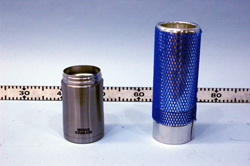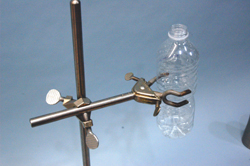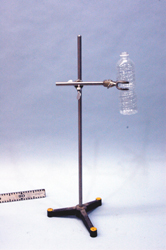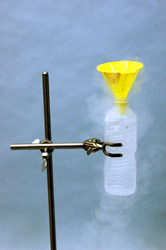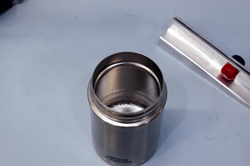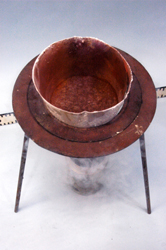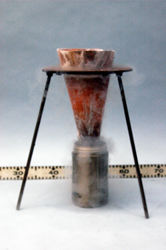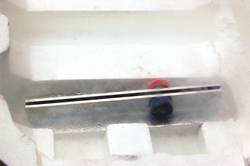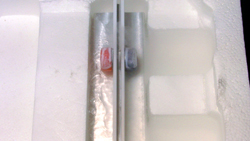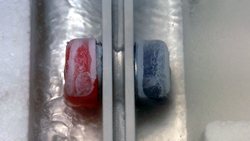|
Size: 1645
Comment:
|
← Revision 17 as of 2013-07-12 18:17:40 ⇥
Size: 4560
Comment: converted to 1.6 markup
|
| Deletions are marked like this. | Additions are marked like this. |
| Line 2: | Line 2: |
| ||<:30%>[:PiraScheme#Mechanics: Table of Mechanics Demonstration]||<:30%>[:MEEquipmentList: List of Mechanics Equipment & Supplies]||<:30%>[:Demonstrations:Lecture Demonstrations]|| | ||<:30%>[[PiraScheme#ElectricityAndMagnetism| Table of Electricity & Magnetism Demonstration]]||<:30%>[[EMEquipmentList| List of Electricity & Magnetism Equipment & Supplies]]||<:30%>[[Demonstrations|Lecture Demonstrations]]|| |
| Line 7: | Line 7: |
| Magnetic Materials, [:MagneticMaterials#ParamagDiamag: 5G30. Paramagnetism and Diamagnetism] | Magnetic Materials, [[MagneticMaterials#ParamagDiamag| 5G30. Paramagnetism and Diamagnetism]] |
| Line 10: | Line 10: |
| * '''Cabinet:''' [:MechanicsCabinet:Mechanic (ME)] * '''Bay:''' [:MechanicsCabinetBayA1:(A1)] * '''Shelf:''' #1,2,3.. |
* '''Cabinet:''' [[EMCabinet|(E&M)]] * '''Bay:''' [[EMCabinetLtBayA3|(A3)]] * '''Shelf:''' #5 |
| Line 14: | Line 14: |
| attachment: mainPhoto | {{attachment:Setup02-400.jpg}} |
| Line 22: | Line 22: |
| ||Steel Channel|| || || ||Liquid N2|| || || ||Water Bottle|| || || ||Small Dewar|| || || |
||Aluminum Channel ||E&M-Left Side Cabinet, Bay A3, Shelf #5 || || ||Liquid N2 (Main Supply)||Loading dock|| || ||Water Bottle || Supply own (or look in trash/recycling)|| || ||Copper Cone || E&M-Left Side Cabinet, Bay A3, Shelf #5 || || ||Small Dewar || Glassware cabinet|| || ||Stand with Clamp || Rod and clamp cabinet || || |
| Line 30: | Line 32: |
| * '''''This demonstration requires about 1 L of liquid N2.''''' * '''''It takes roughly 20 minutes to make enough liquid air for this demonstration.''''' |
|
| Line 34: | Line 38: |
| 1. List steps for setup then procedure. 1. ... |
1. Use clamp to attach water bottle to stand. 1. Fill the bottle with liquid nitrogen. 1. Pre-cool the small dewar by pouring in about 200 mL of liquid nitrogen. 1. Allow the nitrogen to stop boiling, and then pour it out. 1. Lower the bottle into the dewar. After 20 minutes, about 50 mL of liquid air will have condensed in the small dewar. 1. On the higher side of the steel channel relative to the magnets, pour the liquid air into the channel. 1. The oxygen component of the liquid air will be trapped in the magnetic field while the rest runs off. Alternative Setup/Procedure: 1. Follow above setup/procedure replacing the stand w/clamp and water bottle with the copper cone and a ring stand. 1. To decrease the rate at which the liquid oxygen boils off, the aluminum channel and magnets can also be pre-cooled as part of step 3 above. See pictures below for example. |
| Line 38: | Line 51: |
| * | * '''Exercise great care when handling the liquid N2 - it can cause severe frost bite!''' * '''NEVER put a cap on the container containing the liquid N2! Doing so would create a very DANGEROUS device that will explode sending shards of plastic into the audience.''' * '''Liquid oxygen is EXTREMELY FLAMIBLE! Keep away from sparks or sources of open flame.''' |
| Line 43: | Line 58: |
| Discuss the physics behind the demonstration, explaining some of the various steps of the demonstration when appropriate. | Air is a mixture of various gases. Roughly speaking, air is 78% N2, 21% O2, and 1% Ar while the other contributions from H2, C02, He, etc. are negligible. N2, Ar, He, H2 are all diamagnetic meaning that their respective magnetic dipole moments will anti-align themselves with the magnetic field causing a repulsion. 02 is the only component of our atmosphere that is paramagnetic meaning that the magnetic dipole moment is aligned with the magnetic field and so will be attracted. Thus, the trapped liquid will be pure oxygen. It will remain their until it gains energy from the hotter surrounding air and boils off. |
| Line 45: | Line 60: |
| ||attachment: photo||attachment: photo||attachment: photo||attachment: photo|| | ||{{attachment:ChannelBigSmallDewars02-250.jpg}}||{{attachment:Channel04-250.jpg}}||{{attachment:Channel01-250.jpg}}||{{attachment:SmallDewars02-250.jpg}}|| ||{{attachment:SmallDewars04-250.jpg}}||{{attachment:SmallDewars05-250.jpg}}||{{attachment:BottleStand01-250.jpg}}||{{attachment:BottleStand02-250.jpg}}|| ||{{attachment:FilledBottleFunnel03-250.jpg}}||{{attachment:LN2Boil01-250.jpg}}||{{attachment:BottleCondensing01-250.jpg}}||{{attachment:ConeStand01-250.jpg}}|| ||{{attachment:ConeStand03-250.jpg}}||{{attachment:ConeStand04-250.jpg}}||{{attachment:ConeBoil02-250.jpg}}||{{attachment:ConeDewar01-250.jpg}}|| ||{{attachment:CoolChannel01-250.jpg}}||{{attachment:LOxygen06-250.jpg}}||{{attachment:LOxygen04-250.jpg}}|| |
| Line 48: | Line 67: |
| * [http://youtu.be/UfYExGQrkwM The Paramagnetism of Liquid Oxygen, 5G30.20] * [https://www.youtube.com/user/LectureDemostrations/videos?view=1 Lecture Demonstration's Youtube Channel] |
* [[http://youtu.be/UfYExGQrkwM|The Paramagnetism of Liquid Oxygen, 5G30.20]] * [[https://www.youtube.com/user/LectureDemostrations/videos?view=1|Lecture Demonstration's Youtube Channel]] |
| Line 53: | Line 72: |
| * List any references | * [[http://en.wikipedia.org/wiki/Paramagnetism|Paramagnetism - Wikipedia]] * [[http://en.wikipedia.org/wiki/Liquid_oxygen|Liquid Oxygen - Wikipedia]] |
| Line 56: | Line 76: |
| [:Instructional:Home] | [[Instructional|Home]] |
Paramagnetism of Liquid Oxygen, 5G30.20
Topic and Concept:
Magnetic Materials, 5G30. Paramagnetism and Diamagnetism
Location:
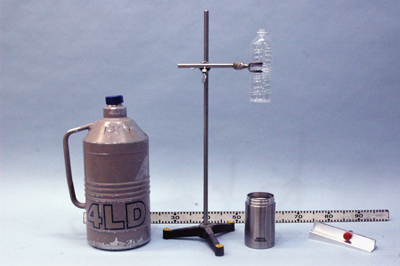
Abstract:
Liquid oxygen is trapped in a strong magnetic field until it evaporates.
Equipment |
Location |
ID Number |
|
|
|
Aluminum Channel |
E&M-Left Side Cabinet, Bay A3, Shelf #5 |
|
Liquid N2 (Main Supply) |
Loading dock |
|
Water Bottle |
Supply own (or look in trash/recycling) |
|
Copper Cone |
E&M-Left Side Cabinet, Bay A3, Shelf #5 |
|
Small Dewar |
Glassware cabinet |
|
Stand with Clamp |
Rod and clamp cabinet |
|
Important Setup Notes:
This demonstration requires a 24 hour notice.
This demonstration requires about 1 L of liquid N2.
It takes roughly 20 minutes to make enough liquid air for this demonstration.
Setup and Procedure:
- Use clamp to attach water bottle to stand.
- Fill the bottle with liquid nitrogen.
- Pre-cool the small dewar by pouring in about 200 mL of liquid nitrogen.
- Allow the nitrogen to stop boiling, and then pour it out.
- Lower the bottle into the dewar. After 20 minutes, about 50 mL of liquid air will have condensed in the small dewar.
- On the higher side of the steel channel relative to the magnets, pour the liquid air into the channel.
- The oxygen component of the liquid air will be trapped in the magnetic field while the rest runs off.
Alternative Setup/Procedure:
- Follow above setup/procedure replacing the stand w/clamp and water bottle with the copper cone and a ring stand.
- To decrease the rate at which the liquid oxygen boils off, the aluminum channel and magnets can also be pre-cooled as part of step 3 above. See pictures below for example.
Cautions, Warnings, or Safety Concerns:
Exercise great care when handling the liquid N2 - it can cause severe frost bite!
NEVER put a cap on the container containing the liquid N2! Doing so would create a very DANGEROUS device that will explode sending shards of plastic into the audience.
Liquid oxygen is EXTREMELY FLAMIBLE! Keep away from sparks or sources of open flame.
Discussion:
Air is a mixture of various gases. Roughly speaking, air is 78% N2, 21% O2, and 1% Ar while the other contributions from H2, C02, He, etc. are negligible. N2, Ar, He, H2 are all diamagnetic meaning that their respective magnetic dipole moments will anti-align themselves with the magnetic field causing a repulsion. 02 is the only component of our atmosphere that is paramagnetic meaning that the magnetic dipole moment is aligned with the magnetic field and so will be attracted. Thus, the trapped liquid will be pure oxygen. It will remain their until it gains energy from the hotter surrounding air and boils off.
|
|
|
|
|
|
|
|
|
|
|
|
|
|
|
|
|
|
|
Videos:
References:



